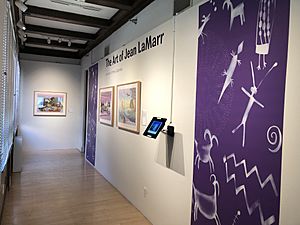Jean LaMarr facts for kids
Quick facts for kids
Jean LaMarr
|
|
|---|---|
| Pahime Gutne | |
| Born | 1945 |
| Nationality | Susanville Indian Rancheria, American |
| Education | San Jose City College |
| Alma mater | University of California, Berkeley |
| Known for | printmaking, murals |
Jean LaMarr, born in 1945, is a talented artist and activist from California. She is a member of the Northern Paiute and Achomawi tribes. Jean LaMarr creates many different kinds of art, including large wall paintings called murals, prints, and sculptures. She is also an official citizen of the Susanville Indian Rancheria.
Contents
Growing Up
Jean LaMarr was born in Susanville, California. Her Native American name is Pahime Gutne, which means "Purple Flower Girl." Her family did not have much money. When she was in fourth grade, she painted her first mural. It was called "Sir Frances Drake Christianizing the Indians." This experience was very important to her. She faced unfair treatment from teachers at school because she was Native American. At home, she had to hide her art from her father. He wanted her to choose a job that seemed more practical.
Her Education
Jean LaMarr studied art at several colleges. She went to San Jose City College from 1970 to 1973. Then she studied at the University of California, Berkeley, from 1973 to 1976. She also attended the Kala Art Institute for many years.
While at UC Berkeley, some of her teachers did not like her style of art. They preferred art that was not realistic. During her time in San Jose, she supported the Occupation of Alcatraz. This was a protest where Native Americans took over Alcatraz Island to bring attention to their rights. Later, she joined other artists who spoke out against unfair treatment. The "Third World strike" in Berkeley in 1969 also influenced her art. She was also inspired by Chicano artists like Ester Hernández and Malaquias Montoya.
Her Art Career

From 1973 to 1990, Jean LaMarr taught art at many places. These included the College of Marin and San Francisco State University. She is well-known for her murals and her prints. She likes these art forms because she believes they are for everyone.
Jean LaMarr once said, "I believe that art is for everyone." She feels that art should not just be in museums or for rich people. She thinks it should be in everyone's home. This is why she started painting murals. She also got into printmaking for the same reason. She saw it as a way to bring people together. It was also a way to make people more aware of important issues. These issues included what was happening to the Earth, Native American rights, and the rights of Native American women.
A curator named Jan Rindfleisch has written about Jean LaMarr's work. She said that Jean LaMarr has supported Native American communities for 40 years. Her art tells stories that show the presence of Native Americans. She often focuses on women, celebrating their history and strength.
Jean LaMarr also started the Native American Graphic Workshop.
In 2022, the California Society of Printmakers honored Jean LaMarr. They gave her a special lifetime membership. This was to recognize her important work in fine art printmaking.
In 2022, the Nevada Museum of Art opened a special show called The Art of Jean LaMarr. This show featured more than 60 of her artworks. It then traveled to the Boise Art Museum in Idaho. It also went to the IAIA Museum of Contemporary Native Arts in New Mexico. The exhibition included prints, paintings, and sculptures. Many of these works focused on Native American women. They also looked at unfair ideas about Native people. Her art challenges racist ideas about Native people, especially women. It also talks about the effects of colonialism and environmental fairness.
Debra Harry, a professor of Indigenous Studies, wrote about the art in the exhibition. She said that Jean LaMarr speaks with great pride in her Native heritage. She is willing to challenge the unfair treatment Native people face. Harry added that LaMarr's art has sharp political messages. Yet, it can also show the softness and beauty of Native cultures, especially Native women.
Her Family Life
Jean LaMarr was married to DeeRoy "Spence" Spencer. He was a Navajo man and a veteran of the Vietnam War. He passed away in 2015. Jean and Spence had one son together.
After Spence passed away, there was a disagreement about where he should be buried. The Navajo Nation decided he should be buried in Arizona, where he was born. However, Jean LaMarr said that he wanted to be buried in their community in Susanville.
Her Artworks
Prints
- Sacred Places Where We Pray, photo etching, 1990
- 500 Years of Resistance: Through Women's Eyes, screenprint, 1992
Murals
- Our Ancestors, Our Future, mural, Susanville
- The Ohlone Journey, mural, Berkeley, California
Art Shows
Jean LaMarr's art has been shown in many exhibitions:
- 1987: The Ethnic Idea, Berkeley Art Center, California
- 1995: Violetly Volatile: Selected Mixed Media Works from 1974 to 1995, C.N. Gorman Museum, California
- 2019–20: When I Remember I See Red: American Indian Art and Activism in California, Crocker Art Museum, California
- 2022–23: The Art of Jean LaMarr, Nevada Museum of Art, Reno; Boise Art Museum, Boise; IAIA Museum of Contemporary Native Arts, Santa Fe, NM
- Princess Pale Moon exhibition, Heard Museum, Phoenix, Arizona

